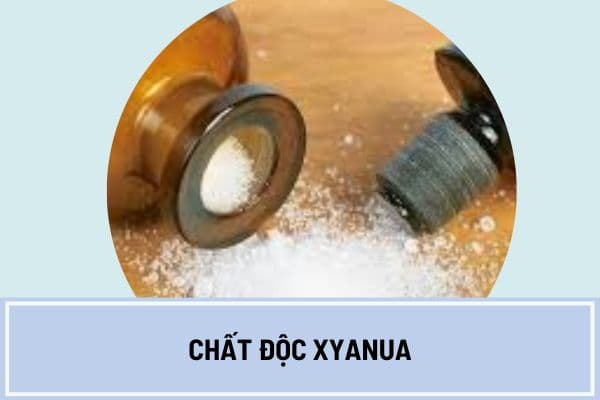Vietnam: What is the smell of cyanide? What is the toxicity of cyanide? What are the symptoms of cyanide poisoning?
What is the smell of cyanide? What are the symptoms of cyanide poisoning?
According to the Destruction or Recycling of Cyanide Technology Process issued with Decision 1971/1999/QD-BKHCNMT in Vietnam, cyanide poison is defined as follows:
INTRODUCTION
Hydrocyanic acid and its soluble cyanide salts are very strong poisons, only about 50 mg can kill a person. However, the metal salts of Hydrocyanic acid play an important role in many industries:
- Gold, silver, copper plating industry or other metals.
- Gold mining industry - gold extraction by cyanidation method.
- Production of colored pigments used in the paint industry, drawing powders, dyeing which require cyanide salts as raw materials.
- Pesticide industry: calcium cyanide to kill aphids and insects in residential homes.
In pharmaceuticals, hydrocyanic acid is used in saline form such as Hg(CN)2 or in combined form such as cherry water at a 1% HCN ratio.
Cyanide is an extremely toxic substance but is widely used in production; therefore, without strict and feasible regulations in importing, distributing, preserving, using, and pollution control steps, cyanide can cause great harm to the environment and human health.
Every year, there are many cyanide poisoning cases in our country: using cyanide to poison each other, working in places with high concentrations of HCN, (CN)2 without protective means or due to carelessness. Moreover, the indiscriminate illegal gold mining areas, manual plating facilities are the places that discharge cyanide poison into the soil and water, causing environmental pollution and destroying species. Therefore, establishing and issuing a technology process for cyanide destruction or recycling is an urgent task to meet practical requirements.
The process includes the following contents:
- Physical, chemical properties, and toxicity of hydrocyanic acid and cyanide.
- Methods of testing hydrocyanic acid and cyanide.
- Sources of cyanide residues causing environmental pollution in gold mining.
- Methods of cyanide destruction.
- Technology processes for cyanide destruction or recycling for reuse.
Cyanide is an extremely toxic substance but is widely used in production.
Cyanide poison is described as having a smell resembling bitter almonds but sometimes as odorless, making it very difficult to distinguish cyanide from other chemicals.
According to the Destruction or Recycling of Cyanide Technology Process issued with Decision 1971/1999/QD-BKHCNMT in Vietnam, symptoms of cyanide poisoning are stated as follows:
- Acute poisoning: Occurs when inhaling or ingesting a high dose of HCN. Poisoning occurs very rapidly, the brainstem centers are paralyzed, the victim loses consciousness, has seizures, and muscles stiffen. Breathing is interrupted and stops, the heart beats very quickly and irregularly; the victim dies after 1 - 2 minutes.
- Subacute poisoning: Common symptoms are dizziness, nausea, headache, respiratory mucosa irritation. Victims feel fear, anxiety but remain alert; thereafter, neurological disorders, seizures, pupil dilation, jaw stiffness, and suffocation begin, victims die after 20 minutes. If promptly rescued, the victim does not die but suffers from heart damage and organ paralysis.
- Chronic poisoning: Occurs to those who regularly work in places where HCN gas is released. Clear symptoms are headache, dizziness, vomiting, and fatigue.

Vietnam: What is the smell of cyanide?
Where can people in Vietnam buy cyanide poison?
According to Decision 1971/1999/QD-BKHCNMT, cyanide is an extremely toxic substance but is widely used in production such as:
- Gold, silver, copper plating industry or other metals.
- Gold mining industry - gold extraction by cyanidation method.
- Production of colored pigments used in the paint industry, drawing powders, dyeing which require cyanide salts as raw materials.
- Pesticide industry: calcium cyanide to kill aphids and insects in residential homes.
...
Every year, there are many cyanide poisoning cases in our country: using cyanide to poison each other, working in places with high concentrations of HCN, (CN)2 without protective means or due to carelessness.
According to Clause 1, Article 18, Decree 113/2017/ND-CP, Appendix I, II, III Decree 113/2017/ND-CP (amended by Clause 3, Article 9 Decree 17/2020/ND-CP), the types of cyanide toxins are not prohibited from sale according to Appendix III Decree 113/2017/ND-CP.
Individuals or organizations wishing to trade in these toxic chemicals only need to comply with the provisions of the Chemical Law 2007 and Decree 113/2017/ND-CP
People who need to use this cyanide poison can easily buy it at shops where individuals or organizations trade toxic chemicals.
What is the toxicity of cyanide?
According to the Destruction or Recycling of Cyanide Technology Process issued with Decision 1971/1999/QD-BKHCNMT in Vietnam, the toxicities of cyanide poison are stated as follows:
- Hydrocyanic acid affects the cellular respiration process by paralyzing the iron enzymes of cytochrome oxidase or the red Warburg enzyme. Due to lack of oxygen, the blood in the veins is dark red, and there are symptoms of suffocation.
- Hydrocyanic acid is rapidly toxic through the respiratory tract; with a dose of 0.3 mg/1 kg body weight, it can cause immediate death.
Concentrations from 0.12 - 0.15 mg/l cause death within 30 minutes to 1 hour.
Through digestion: the fatal dose is 1 mg/1 kg body weight for salts like KCN, NaCN.
- Hydrocyanic acid can penetrate the body and cause poisoning by seeping through external skin wounds.
The allowed repeated exposure concentration in the air is 10 ml/m³ or 11 mg/m³ of air at 200.
LawNet